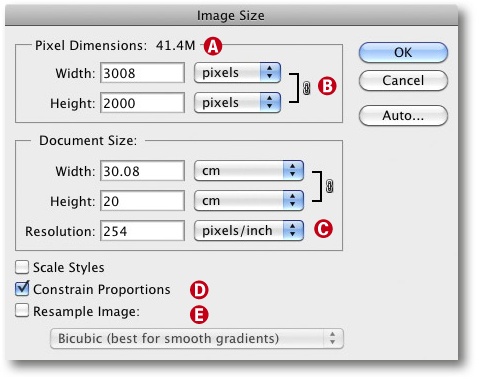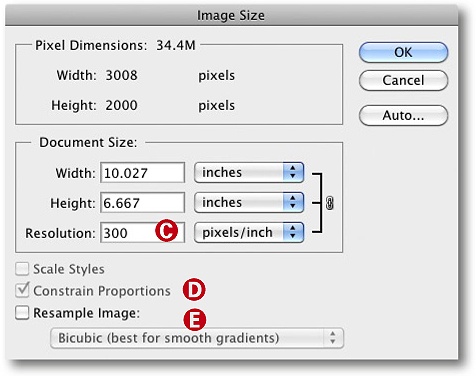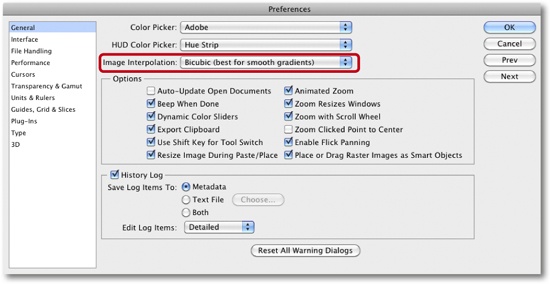Image size and resolution are stated in different and often confusing units. Here is a quick overview of the commonly used naming systems and labels:
File Size depends on the format and compression rate you use to save your image. File size is stated in KB or MB. The image in Figure 4-5 is a compressed TIFF at about 41,4 MB. The same image requires about 15 MB of disk space as a compressed JPEG. File size can vary enormously!
Image Size in Pixels is stated using the height and width of the image as it is captured by the camera. A Nikon D70 produces images measuring 3008 × 2000 pixels (i.e., 6.1 million pixels, or 6 megapixels). The rule of thumb here is: “more is better”.
Resolution is stated in pixels per inch (ppi). An uncropped photo print shot using a Nikon D70 and printed at 300 ppi results in a print size of:
3008/300 × 2000/300 = 10.02″ × 6.66″ (24.46 cm × 16.93 cm)
If you print the same image on an inkjet printer at 180 ppi, the image size would be:
3008/240 × 2000/240 = 12.53″ × 8.33″ (31.83 cm × 21.17 cm)
Printers (and other output devices) have resolution that is stated in (ink) dots per inch (dpi). Inkjet printer resolution is typically between 1400 and 5760 dpi. However, inkjet printers simulate halftones using closely grouped collections of extremely small dots and thus print many fewer dots (180–300 ppi) than the image actually has. We therefore recommend that you print on inkjet printers at resolutions between 180 and 360 dpi. The correct input resolution (in ppi) depends on the type of output device you are using (see also The Journey from Pixel to Printed Dot).
Pre-press applications still use the lines per inch (lpi) unit. This term is explained in The Journey from Pixel to Printed Dot.
Monitors have a resolution of between 72 and 100 pixels per inch (72–100 ppi).
Note
![]() Halftones are simulated using collections of tiny printed dots and a process called “dithering”.
Halftones are simulated using collections of tiny printed dots and a process called “dithering”.
We have produced acceptable results at resolutions of 180–360 ppi using our high-end printers.
What happens if we use the Photoshop Image Size dialog to adjust the width, height, or resolution of an image? The results depend on the settings you make (see Figure 4-6):
Constrain Proportions: Always use this option if you want to avoid skewing your image.
Resample Image: This option is used to produce larger or smaller versions of your image, but causes image quality loss in the process – especially if you enlarge your image. Resampling changes the number of pixels in your image. If you deactivate resampling, the image data remains unchanged, and only the physical output size (of your print, for example) changes.
Scaling is one of the most common (and critical) changes made to digital images, and it should be performed with care and forethought.
If you only adjust the ppi resolution C (with option E deactivated) you won’t alter the actual image data, but only the fictional pixels per inch value. This operation is therefore simple and reversible, and requires virtually no computing power. The output size changes without affecting the number of pixels in the image.
We can reduce the output resolution to 200 ppi/dpi for our Epson inkjet printers without affecting the quality of the results too much. If, however, you reduce resolution too far, your results will become grainy.
Note also that appropriate print resolution depends on the print medium. Normal paper is very absorbent and thus requires a lower resolution if you want to avoid the individual pixels running into each other and smearing. Finer papers and photo papers (glossy, premium, or better) allow you to use higher resolutions and thus achieve more detailed prints without visible pixelation effects.
If you enlarge an image for printing, your program will produce (i.e., invent) new pixels.[59] Although enlargements can produce surprisingly good results, the effect of the invented pixels is still not the same as if you took the photo with a higher pixel resolution. Only enlarge images as much and as often as you have to. Photoshop offers three different ways to scale images:
Nearest Neighbor: This method is not suitable for photographic applications. We do, however, use it for preserving the pixelated effect in screenshots enlarged for book use.
Bilinear: This is also unsuitable for photographic use
Bicubic: This can be used for enlargements with a factor of up to 1.5
Bicubic Smoother: This is the best choice for significant enlargement.
Bicubic Sharper: This method is great for reducing images, thanks to its slight built-in sharpening effect.
There are also a number of other specialized commercial and noncommercial scaling tools available. The Photoshop tools we have mentioned are, however, a good starting point for achieving great results without having to spend money on additional software. If you need to enlarge lots of images on a regular basis, it is worth taking a look at some of the specialized tools on the market to see if they better suit your needs.
Our own DOP-Upsizing Photoshop plug-in can be used to make effective moderate enlargements and is available as a free download at [73]. There is also an interesting article on the subject by Jack Flesher at the same website.
Other tools for enlarging images while minimizing quality loss are pxl SmartScale from onOne Software (www.ononesoftware.com), or the freeware imageN (www.pixoid.com).
We recommend that you set the Image Interpolation setting to Bicubic in the General section of the Photoshop Preferences dialog. This ensures that the bicubic method is applied if no other explicit settings are made (Figure 4-7).
[59] These are usually calculated from the average values of neighboring pixels using special algorithms.




